Invisalign® Clear Aligners Nepean
A Clear & Simple Path to Straight Teeth
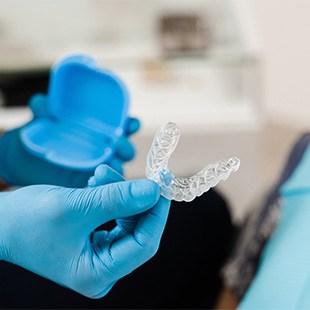
Whether your teeth are crooked or there are small spaces between them that make you feel self-conscious, the idea of wearing metal braces may not appeal to you. That’s pretty natural – many folks don’t want to deal with brackets and wires as adults. The bright side is that you can get a straight smile with Invisalign® clear aligners in Nepean! This approach won’t saddle you with a “metal mouth” and makes the alignment process much smoother. To find out more about this orthodontic treatment, read on to schedule a visit to see us here at Fisher Dental.
Why Choose Fisher Dental for Invisalign®?
- Treatment Plans Tailored to Each Patient
- Custom-Made Aligner Trays for Accurate Results
- Highly-Skilled, Experienced, & Compassionate Dentist
How Invisalign Works
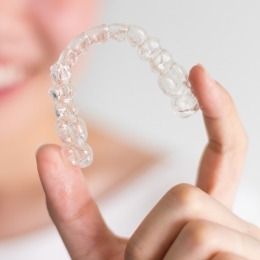
Unlike metal braces, Invisalign doesn't set brackets and wires on your teeth. It actually uses sets of clear custom trays – “aligners” – to straighten your smile over time. These trays are custom-made for you, so they apply constant pressure on your teeth to shift them to the right spots. In terms of rules, you just need to wear them for 20-22 hours a day and switch out the sets every 1-2 weeks. These guidelines (as well as follow-up visits with Dr. Bal) will help your teeth straighten out bit by bit until you reach your ideal results.
Who Invisalign® Can Help

In addition to being discreet, comfortable, and hassle-free, Invisalign® is versatile. In other words, it can help folks with crowded teeth, overbites, and just about everything in between. You can read on to learn more, or you can schedule a consultation with us to find out if you’re a candidate!
Crowded Teeth
Unfortunately, overlapping teeth can have a negative effect on your self-esteem as well as your oral health. So, don’t wait – schedule a consultation with us today to find out if clear aligners are an option! If the answer is “yes,” then straightening your teeth won’t involve any metal at all.
Gaps Between Teeth
Patients usually have either one large gap between their two front teeth or several smaller gaps throughout their mouth. In both cases, we can close the gaps with Invisalign® (as long as your case isn’t too complex, of course). Plus, you’ll be able to watch each improvement because the aligners are clear!
Bite Alignment
In addition to straightening your teeth, we want to align your bite. That way, you can chew properly, enunciate clearly, and avoid common consequences of misaligned bites, like chronic jaw pain. Thankfully, Invisalign® can correct overbites, crossbites, underbites, and open bites.
The Benefits of Invisalign®

When you compare Invisalign® to metal braces, you can see why many patients prefer to try clear trays: they tend to lead to a smooth treatment process!
It all comes down to the many unique benefits of Invisalign®. For starters, its trays are much more subtle and discreet than braces that have shiny metal. The aligners are also more comfortable – they won’t poke or prod mouth tissues like brackets and wires can. Indeed, their plastic lets your lips and tongue move without injury and lets you remove the trays for meals and oral care. Invisalign even goes faster, as its trays can straighten your teeth in 1-2 years compared to braces' 2-3 years.
Understanding the Cost of Invisalign®
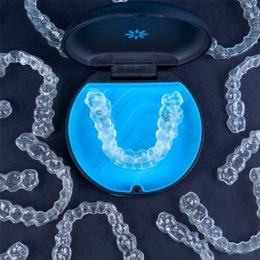
In short, there isn’t a flat fee for Invisalign®. Instead, each treatment plan is created with factors unique to the patient in mind, including the complexity of their case. The good news is that we can provide you with an estimate of the cost at your consultation. Additionally, we can review the available financial solutions at that time, including our DentalCard Financing service. In the meantime, you can read on to learn more about the price!
Factors That Affect the Cost of Invisalign®
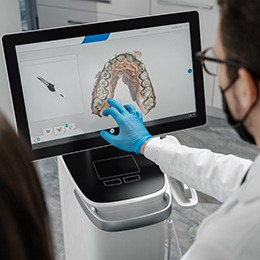
We mentioned above that the complexity of your case will impact the cost of your Invisalign® treatment. That’s true, but there are other factors we need to consider as well. In addition to determining how many aligners are needed, we need to see if rubber bands or any other orthodontic accessories need to be added and decide which type of aligner is best for you. Whether or not any preliminary treatments are necessary, like gum disease therapy, also needs to be considered. Don’t worry – we will cover all of this information with you at your consultation so you know both the price and how we got to it.
Invisalign® vs. Mail-In Aligners: Which Costs More?
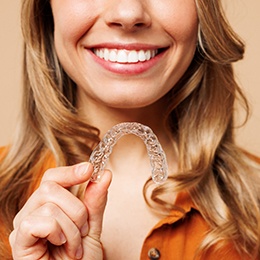
Mail-in aligners typically cost less because they cut corners. For example, they bypass the initial exam. They also rely on DIY impressions and typically don’t have a licensed dental professional overseeing the treatment plans. So, while they are cheaper, they certainly aren’t better. When it comes to something as important as the look, health, and function of your smile, you want to select an orthodontic treatment that is safe, effective, and reliable. That’s Invisalign®; it was invented over two decades ago now, and it has helped more than 17 million patients so far!
Does Dental Insurance Cover Invisalign®?

Sometimes, yes! The easiest way to find out if your provider will cover a portion of the cost of Invisalign® is by reading through the fine print on your plan. You can also ask us for help! We are happy to help our patients utilize their benefits so their valuable dollars go toward maintaining, restoring, and enhancing their smiles. Simply provide us with your membership information at your consultation. We’ll take it from there!
Options for Making Invisalign® Affordable

If you don’t have dental insurance, then ask us about other ways you can save! For example, you can space out the cost of your care into smaller, more manageable chunks with flexible financing. You can also take a look at our latest specials to see if we are running a promotion on Invisalign®, like $0 down for new patients. We will go over these financial solutions more in-depth at your consultation as well, and we’d be happy to answer any questions you have about the cost at that time.
Invisalign FAQs
How Do I Clean My Invisalign?
It’s a pretty simple matter to clean Invisalign trays. Depending on your preferences, you can take several approaches.
For example, you could just brush your aligners like natural teeth. You’d only need to use a soft-bristled toothbrush for this method. At the same time, a patient should rinse the trays daily to prevent debris buildup. Just avoid hot water for this latter step; it’ll warp your aligners’ plastic.
Another idea is to use dedicated aligner products. Invisalign happens to sell its own cleaning system, which you could buy to maintain the trays. This system’s cleaning crystals would shake built-up debris and plaque from your aligners.
Can You Smoke During Invisalign Treatment?
While smoking is already bad for most folks, it’s even worse for Invisalign patients. The habit harms one’s oral health and delays treatment progress. With that said, you shouldn’t smoke during the alignment process.
You see, the smog and nicotine from cigarettes are bad for Invisalign. They tend to discolor aligners when you smoke with your trays in your mouth. As that happens, the plastic becomes more visible and draws unwanted attention to your smile.
It’s also bad to remove your aligner trays just to smoke. After all, doing so means you may not meet your 20–22-hour Invisalign wear time. That risk is especially high if you’re a heavy smoker.
Does Invisalign Give You a Lisp?
Invisalign trays can cause a lisp for some patients. When present, this speech impediment stems from the extra plastic in your mouth.
You see, lisps are caused by improper tongue placement. That becomes more likely when aligners alter the space within the mouth. Indeed, the alteration can make the tongue move differently around your teeth and affect your pronunciation.
All that said, many Invisalign patients don’t suffer from this issue. They’ll often subconsciously adjust their tongues to compensate for the trays’ presence. Even if a patient has a lisp at first, it quickly fades as the patient learns to speak with aligners.
How Long Does Invisalign Take?
The average treatment time for Invisalign is about 12 to 18 months. Still, many factors can affect how long you need to wear your trays – severity of misalignment, commitment to care, etc.
Say you only have minor misalignments, for instance. You may be able to finish Invisalign treatment in a mere six months or so. After all, your trays wouldn’t need to do much to correct your smile.
In contrast, severe misalignments can take up to 18 months to fix. That may seem like a long time, but it’s still four months less than the average timeline for metal braces. You’d still be getting a highly efficient treatment.
